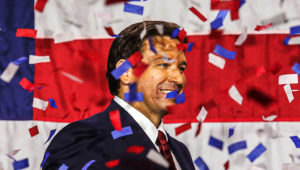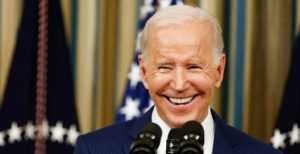To the Right, he is the senile puppet of “woke” plutocrats; to the Left, he is a corpse filling a blue suit while corporations steer the ship of state. But if you look at the facts, President Joe Biden appears to be doing alright.
Admittedly, expectations were low: an elderly caretaker of America. But Biden’s administration has promoted policies that, were the stuttering octogenarian a more charismatic ideologue, either Left or Right might have excitedly endorsed. There was the withdrawal of American forces from Afghanistan; the $1.9 trillion American Rescue Plan Act, which facilitated a surprisingly smooth pandemic recovery; and the $1 trillion bipartisan Infrastructure Investment and Jobs Act, supported by almost three quarters of voters. Along the way, he has presided over a hot-and-cold economy that continues to offset rising inflation with suspiciously strong job creation numbers, even as other key indicators still point toward a looming long-term recession.
Biden has been lucky, remarkably so — the party’s midterm election performance in 2022 was unexpectedly strong. A punishing loss for the party holding the presidency is usually taken as a fait accompli. The party even expanded its majority in the Senate. In part, this success stemmed from the Democrats’ ability to fend off far-Right challenges from candidates who had managed to seize victory in Republican primaries thanks to the backing of important figures like ex-president Trump. In other words, the GOP has been hamstrung by its drift towards its more extreme ends.
Biden’s greatest asset, meanwhile, has been his wobbly centrism — a late-stage, cracked-mirror version of the pugnacious, energetic centrism that made him a presidential front-runner in the 1988 Democratic primaries, until allegations of plagiarism in his speeches and academic work torpedoed his candidacy. In the style of a grandparent simply unable to hear the complaints of his arguing grandchildren, Biden has alternated between offering lip service to the social-justice issues that animate his party’s Left-wing base, while reiterating his own more traditional support for police, law and order, and the middle class.
It’s hardly surprising, then, that Biden has given every indication that he will run for re-election in 2024. Genuine one-term presidential administrations are rare — only three presidents served four years and chose not to run again. But Biden is still working on borrowed time. There are a variety of ongoing issues that could take a turn for the worse. The long-promised Russian offensive in eastern Ukraine could weaken Nato’s resolve to continue subsidising that embattled nation. The layoffs seen primarily in the technology and entertainment sectors could spread more widely across the economy. Mounting infrastructure disasters like the recent train derailment and hazardous materials spill in East Palestine, Ohio could give the administration a black eye. Police shootings such as the violent arrest and death of Tyre Nichols in Memphis could send protestors back to the streets across the United States. All of this could provoke conflicts between Biden and other senior figures in his party, who might apply pressure to prevent him from running again.
Even if he runs and wins, Biden will be 82 when he takes office in 2024. This is unprecedented territory for a democratically elected leader. His health could fail suddenly. The mounting personal scandals involving the handling of confidential documents and his “black sheep” son Hunter could topple, or he could make one too many a gaffe-ridden speech. (Biden recently received praise from 76-year-old former president Donald Trump for delivering a relatively coherent State of the Union Address.) But most alarmingly for the American Left, there are no obvious candidates waiting in the Democratic wings — in fact, Biden’s surprisingly strong performance has caused would-be rivals to fall in line, with The New York Times interpreting the deference of party heavyweights as evidence that it’s “Biden or bust” in 2024.
Whether or not he runs, Biden’s success as a wobbly centrist could serve as a guiding light for his successor. We might even see a candidate with the energy of Biden during his brief Eighties heyday. That Biden, as The Atlantic writer William Schneider explained in a detailed 1988 profile of the leading Democratic candidates, was frequently described as a “completely political creature, in the best sense of the word”, as well as a “guy with unrealised potential” on the cusp of becoming a “political heavyweight”. This version of Biden — still prone to stuttering and fulminating, but far more focused than the current model — was the perfect remedy for a Democratic Party reeling from the failed campaign of traditional Left-leaning presidential candidate Walter Mondale in 1984, and the far-Left insurgencies of Ted Kennedy in 1980 and Jesse Jackson in 1984, which had badly divided the base — just as Bernie Sanders would go on to do in 2016 and 2020. This iteration of Biden was known for “shooting straight” — standing before women’s groups, labour unions, and the NAACP, telling them things they don’t necessarily want to hear.
Biden was one of several promising centre-Left candidates of that era who offered outside-the-box solutions to national problems that the Democratic Party of the New Deal era could not address. What appealed was tough-on-crime talk, to assuage voters’ fears about urban violence; a rollback of social security, to push the long-term unemployed off the dole and back into the workforce; and a move away from unequivocal support for organised labour. The US in 1988 looked a lot more like the country of today than people remember — it was a deindustrialising colossus that was militarily entangled with the Soviet Union and economically out-competed by a rising Japan — and the subsequent prosperity of the Nineties owed in considerable part to the Left’s willingness to steer itself, and the nation, toward the centre.
Biden’s momentary, scandal-ridden downfall in the 1988 primaries was followed by a Democratic resurgence in the 1992 presidential election, during which Bill Clinton wrested the office from George H.W. Bush. Clinton was one of the party’s various late-Eighties rising stars who helped revive its fortunes by appealing to America’s roughly 10 million independent voters — who decided the country’s razor-thin electoral contests in its handful of swing states. This left plenty of room in the party for far-Left stalwarts such as Ted Kennedy, Jesse Jackson and, eventually, Bernie Sanders — old welfare-state lions and civil-rights warriors who could be confined to safe districts. But in states where the parties were competing on relatively even terms, the Democrats needed to field candidates who could at least moderate the party’s rhetoric on more controversial subjects like immigration.
There, the lessons of the Democratic Leadership Council — founded in 1985 by political strategist Al From — paid dividends. Prominent members, including Biden, Clinton and future Vice-President Al Gore emphasised crime, tax reform and welfare reform as a way of winning back middle-class voters. That isn’t to say there weren’t identifiable differences between Democrats and Republicans on these issues; rather, the goal was to minimise or at least talk past those differences, while fielding a non-ideological candidate who was broadly likeable rather than infamous. The tactic worked. So much so that the party was still using it during Barack Obama’s two successful campaigns for the presidency, even if he leavened his centrism with some of the soon-to-be unavoidable social justice rhetoric. In fact, likeability was the chief difference between Barack Obama and Hillary Clinton during their heated primary contest in 2008 — both were moderates, but Obama could speak convincingly to both the base and the general public.
Right now, it is not entirely clear who could carry the torch of centrism. Massachusetts Senator Elizabeth Warren, who was a Republican during the Eighties and Nineties and only changed her party affiliation in 1996, could conceivably moderate the rhetoric she deployed in 2020 to compete with Bernie Sanders — though, at 73, she’s not exactly a spring chicken. Other potential candidates are either untested on the national scene, such as Michigan Governor Gretchen Whitmer, or have been otherwise unsuccessful in their pursuit of national office, such as the Ohio senate candidate Tim Ryan.
The 2022 midterms demonstrated that moderation can win close elections over the vestiges of Trumpism: witness boring former astronaut Mark Kelly beating “based” techbro Blake Masters for an Arizona senate seat, and the uninspiring Raphael Warnock defeating inveterate liar and former football star Herschel Walker in a Georgia runoff. Where Republicans prevailed “bigly”, it was the work of similarly dull, indeed somewhat nerdy, governors with track records to tout: second-generation wonk Chris Sununu in New Hampshire, big stick-wielding former Yale baseball player Ron DeSantis in Florida, and Ohio political lifer Mike DeWine.
In an increasingly polarised country, fearful middle-class swing voters — force-fed a diet of ratings-grabbing news about world calamities and impending social collapse — desire nothing so much as a steady hand on the wheel. Not Ronald Reagan riding in on a horse or Franklin D. Roosevelt chatting by the fireside, but Glenn Youngkin in a red vest or Mark Kelly with a well-shined bald head, each reading a carefully-prepared speech in a well-rehearsed monotone. Whether it arrives sooner or later, the post-Biden future for the Democrats still goes through the centre-Left. Unfortunately, there are plenty of people in the party capable of derailing further efforts toward moderation. The nine progressive members of the House of Representatives who comprise “the Squad” can certainly reach the Democratic base, as Ted Kennedy and Jesse Jackson did during the Eighties, but polling shows that swing voters don’t care for what they’re selling.
As unexciting as it sounds, the American system depends on these swing voters. And what they want is some level of police funding, some level of control over the curriculum in their schools, and a chief executive who will cool off the superheating partisan debate they hear incessantly on the various news entertainment networks. Elderly Biden, years past his competitive peak, managed to deliver a condensed version of this in 2020. Lest it lurch further Left and risk running candidates every bit as unelectable as out-of-touch Walter Mondale in 1984, the party would be well-advised to trade in the President for a newer model as soon as the opportunity presents itself.
Disclaimer
Some of the posts we share are controversial and we do not necessarily agree with them in the whole extend. Sometimes we agree with the content or part of it but we do not agree with the narration or language. Nevertheless we find them somehow interesting, valuable and/or informative or we share them, because we strongly believe in freedom of speech, free press and journalism. We strongly encourage you to have a critical approach to all the content, do your own research and analysis to build your own opinion.
We would be glad to have your feedback.
Source: UnHerd Read the original article here: https://unherd.com/




